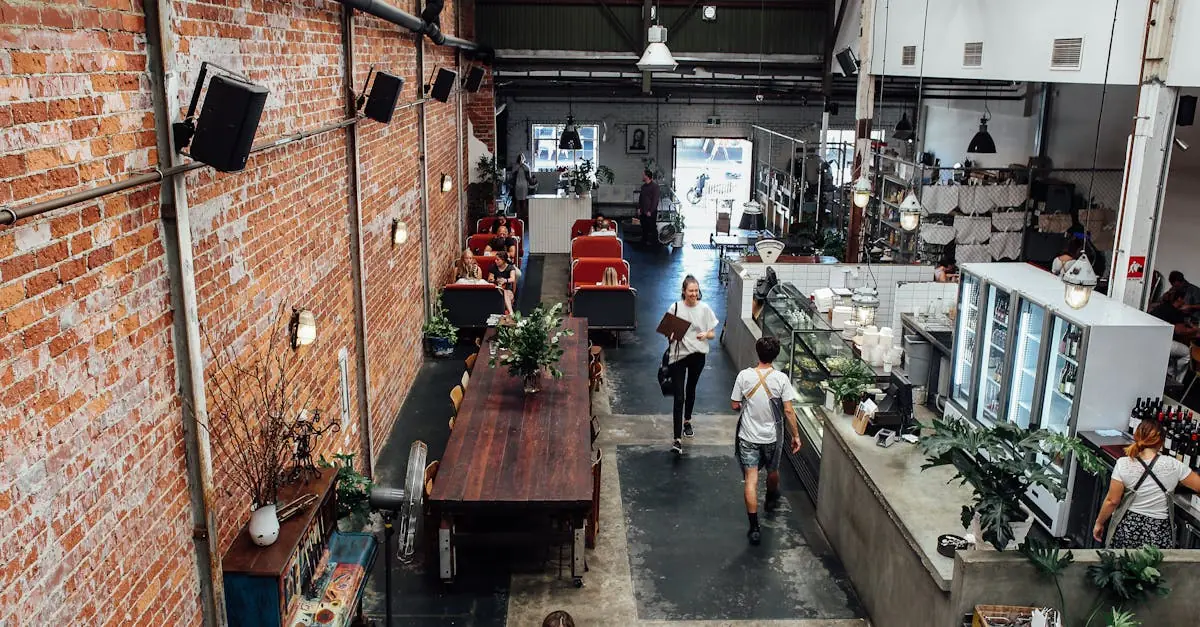The food and beverage industry is buzzing with excitement as it evolves at lightning speed. From plant-based wonders to sustainable packaging, it’s like a culinary rollercoaster ride that keeps everyone on their toes. If you thought avocado toast was the peak of creativity, think again!
Table of Contents
ToggleOverview of The Food and Beverage Industry
The food and beverage industry represents a vital segment of the global economy. Valued at over $5 trillion in 2021, it’s seen significant growth due to changing consumer preferences. Sustainability drives many of these changes as consumers increasingly demand eco-friendly products and practices.
Plant-based products resonate with health-conscious individuals, reflecting a noticeable shift toward vegetarian and vegan options. Innovations in plant-based meat alternatives, such as those developed by Beyond Meat and Impossible Foods, illustrate this trend’s impact.
Technology plays a crucial role in enhancing production efficiency and creating a transparent supply chain. Companies leverage data analytics and artificial intelligence to improve inventory management and reduce waste. For example, smart kitchen appliances foster culinary creativity while streamlining cooking processes.
Consumer habits continue evolving with the rise of online food delivery services and meal kits. Platforms like Uber Eats and Blue Apron cater to convenient dining experiences, making it easier for individuals to access diverse cuisines.
Health-oriented beverages thrive in response to the growing interest in wellness. Functional drinks, including kombucha and infused waters, offer flavor while promoting health benefits.
Global health concerns also influence product development. Claims around organic, non-GMO, and gluten-free products gain traction as consumers become more vigilant about their food choices.
The food and beverage industry undergoes constant transformation. These changes reflect broader societal trends toward health, sustainability, and technology, shaping future innovations and consumer experiences.
Health and Wellness Trends
The food and beverage industry focuses heavily on health and wellness, reflecting consumer demands for better choices.
Plant-Based Alternatives
Plant-based alternatives dominate the market as consumers gravitate toward vegetarian and vegan diets. Companies like Beyond Meat and Impossible Foods lead innovations in meat substitutes, showcasing products that appeal to health-conscious individuals. Research shows that over 30% of consumers opt for plant-based options in their meals regularly. Restaurants and grocery stores stock these alternatives more frequently, catering to a diverse range of preferences. Choices encompass everything from dairy-free cheeses to protein-rich legumes, providing ample variety for those seeking healthier options.
Functional Foods
Functional foods have gained traction as consumers seek tangible health benefits from what they eat and drink. Products enhanced with probiotics, omega-3 fatty acids, and antioxidants meet this demand effectively. Market analysis indicates that the global functional foods market is expected to surpass $300 billion by 2024. Beverages such as kombucha and infused waters showcase vital nutrients, attracting health-focused individuals. Daily consumption of these items contributes positively to overall wellness, aligning with modern dietary goals. Companies prioritize transparency in ingredient sourcing, reassuring consumers about the quality of their food choices.
Sustainability in Food Production
Sustainability plays a pivotal role in the evolution of food production. The aim centers around creating eco-friendly and efficient processes that minimize environmental impacts.
Eco-Friendly Packaging
Innovations in eco-friendly packaging demonstrate a rising commitment to sustainability. Many companies now utilize biodegradable materials that decompose naturally, reducing plastic waste. Consumers increasingly prefer brands with sustainable packaging solutions, contributing to a shift in purchasing behavior. According to recent surveys, over 60% of shoppers actively seek products with environmentally friendly packaging. Brands respond by adopting compostable options and minimalistic designs that require fewer materials. This transition not only aligns with consumer values but also fosters a healthier planet.
Waste Reduction Initiatives
Waste reduction initiatives gain momentum as businesses aim to minimize food waste. Strategies such as upcycling surplus ingredients into new products Resonate with environmentally conscious consumers. Many restaurants and manufacturers donate leftover food to local charities, reducing waste while supporting community needs. Data indicates that approximately 1.3 billion tons of food get wasted globally each year, highlighting the urgency for action. Investing in technologies that track inventory and manage supply chains enables companies to optimize resources effectively. These proactive steps reflect a dedication to sustainability and a commitment to responsible food production practices.
Technology Integration
Technology is transforming the food and beverage industry, enhancing efficiency and consumer experience. Data analytics, artificial intelligence, and innovative platforms drive this evolution.
Artificial Intelligence in Food Service
Artificial intelligence (AI) optimizes various aspects of food service, from inventory management to personalized customer experiences. AI systems analyze consumer preferences and predict trends, aiding restaurants in menu design and marketing strategies. Approximately 60% of food service operators report increased efficiency by integrating AI into their operations. These technologies streamline order processing and reduce wait times, leading to greater customer satisfaction. Furthermore, AI-powered chatbots provide quick responses, ensuring seamless communication with customers, while also gathering valuable feedback to improve services.
Online Ordering and Delivery Trends
Online ordering is reshaping the food landscape, fueled by changing consumer habits and advancements in technology. Research shows that over 80% of consumers prefer ordering food online rather than dining out. This trend pushes restaurants to partner with multiple delivery services, enhancing visibility and accessibility. Apps provide real-time tracking, improving customer confidence and satisfaction. Meal kits also gain popularity, offering convenient options for home cooking experiences. Businesses that embrace these digital platforms cater to the demand for convenience, creating new revenue streams and broadening their customer base.
Flavor Innovations
Flavor innovations are transforming the food and beverage industry, reflecting global tastes and the desire for adventurous eating experiences. Consumers now explore diverse flavors as culinary boundaries expand.
Global Cuisine Influences
Global cuisine influences significantly shape current food trends. Asian flavors like kimchi and sriracha frequently appear on menus, driven by an increasing interest in bold, authentic tastes. Latin American ingredients, such as chili peppers and lime, also see a surge in popularity. This blend enhances traditional dishes while offering new twists that excite customers. As over 50% of diners express interest in trying global cuisines, restaurants adapt to meet these evolving preferences. Chefs embrace multicultural ingredients, creating fusion dishes that reflect a world of flavors.
Bold and Unique Flavor Combinations
Bold and unique flavor combinations capture consumer attention, appealing to adventurous palates. Sweet and savory pairings, like chocolate-infused sauces and sea salt, gain traction among culinary enthusiasts. Spicy elements, such as jalapeño or curry, blend seamlessly with traditional ingredients to create unexpected delights. Over 40% of millennials enjoy experimenting with unique flavors, influencing menu designs. This trend leads to innovative offerings, including savory desserts and spicy beverages. Chefs innovate continuously, pushing the boundaries of flavor to provide unforgettable dining experiences.
Consumer Behavior Changes
Consumer behavior in the food and beverage industry shows significant shifts in recent years. The demand for eco-conscious products is rising among consumers, reflecting a growing awareness of environmental issues.
The Rise of Conscious Consumers
Conscious consumers actively seek sustainable and ethical dining options. Approximately 60% of shoppers prefer products with eco-friendly packaging. Health-focused choices and plant-based diets are gaining traction, with over 30% of individuals incorporating plant-based options into their diets. This trend drives brands to adapt, creating offerings that emphasize health, sustainability, and ethical sourcing practices. Restaurants and retailers increasingly reflect these preferences, fostering a new culture of dining that prioritizes well-being and environmental stewardship.
Demand for Transparency and Authenticity
Transparency and authenticity have become vital for consumers. They want to know where their food comes from and how it is produced. Companies are responding by clearly communicating ingredient sourcing and production methods. Research indicates that consumers prioritize brands that showcase ethical practices. Approximately 70% of individuals trust companies that provide transparent information about their ingredients. As a result, brands that prioritize authenticity and clarity are gaining consumer loyalty, shaping the market landscape. The focus on trustworthy information creates relationships between consumers and brands, emphasizing the need for a more informed purchasing process.
The food and beverage industry is thriving on innovation and adaptability. As consumers increasingly prioritize health and sustainability, brands are stepping up to meet these demands with exciting new products and practices. The rise of plant-based options and eco-friendly packaging reflects a significant shift in consumer preferences.
Technology continues to enhance efficiency and transparency, reshaping how food is produced and delivered. Flavor exploration is at an all-time high, encouraging adventurous dining experiences. As the industry evolves, it’s clear that staying attuned to these trends is essential for companies aiming to thrive in this dynamic landscape. The future promises even more creativity and growth as brands embrace these changes, ensuring they resonate with the conscious consumer.



